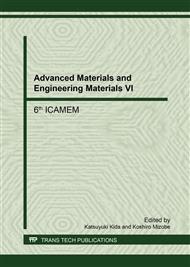p.413
p.418
p.423
p.428
p.433
p.441
p.446
p.451
p.456
Bioleaching and Desulfurization of Pyrite Roasting Residues by NB Bacteria for the Recovery of Cu, Zn and the Magnetic Materials
Abstract:
The experiment focused on the bioleaching and desulfurization of pyrite roasting residues by the bacteria for the recovery of Cu, Zn and the magnetic materials. First of all, the study systematically performed XRD, which provided scientific and technique basis for extraction of valuable metals. Subsequently, the effect of the pH, the temperature and the bacterial inoculum volume ratio on the bioleaching was investigated. The data revealed that the condition under the pH of 1.2, the temperature of 45°C and bacterial inoculum volume ratio of 10% had the most significant effect on the bioleaching and the recovery rates of Cu, Zn and SO42- reached up to 80%, 99% and 80%, respectively. Finally, multi-elements analysis before and after the bioleaching experiments was performed to further explore the ability of the NB bacteria to oxidize the Deerni pyrite roasting residues. The study demonstrated that the total Fe and sulfur contents of the bioleaching residues accounted for 68.47% and 0.28%, respectively. The content of Cu and Zn in the leaching residue were only 0.09% and 0.01%. The desulfurization effects are evident and bioleaching residues meet the requirements as magnetic materials in steel making industry.
Info:
Periodical:
Pages:
451-455
Citation:
Online since:
August 2017
Authors:
Keywords:
Price:
Сopyright:
© 2017 Trans Tech Publications Ltd. All Rights Reserved
Share:
Citation:


